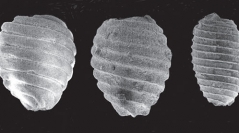

 Cryptogamie, Algologie
27 (4) - Pages 341-356
Cryptogamie, Algologie
27 (4) - Pages 341-356This paper focuses on the ecology of fossil and extant Lychnothamnus barbatus (Characeae), considering the previously described subspecies megalicarpus Soulié-Märsche et Martín-Closas to be only an ecological variant of the species, as indicated by the analyses of proxy evidence from Early-Middle Holocene records from the Ganga plain, India. It is argued that the large-sized gyrogonites, commonly considered as L. barbatus subsp. megalicarpus, are the result of several factors such as oligotrophic status of the water body, shelly clayey silty type of substratum, and deep water, of 6.0m or more. In shallow water, 2.0-3.0 m, mesotrophic basins, only the smaller gyrogonites (comparable to those of the type species from Europe), are developed. The fossil and extant records suggest that the species dispersed progressively towards east and southeast since its earliest Late Miocene record from Western Europe. The Pleistocene records from the Ganga plain, India, and the Gulf of Carpentaria, Australia support the contention of an Asian route of colonization for the Australian population.